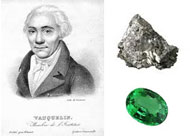 |
Louis Nicolas Vauquelin discovered beryllium in the oxide form in both beryl and emeralds in 1798. Beryllium is a gray-white metal. |
Beryllium
| Atomic Number: | 4 | Atomic Radius: | 153 pm (Van der Waals) |
| Atomic Symbol: | Be | Melting Point: | 1287 °C |
| Atomic Weight: | 9.012 | Boiling Point: | 2469 °C |
| Electron Configuration: | [He]2s2 | Oxidation States: | +2, +1[2] (an amphoteric oxide) |
History
From the Greek word beryllos, beryl; also called glucinium or glucinum, Greek glykys, sweet. Discovered in the oxide form by Vauquelin in both beryl and emeralds in 1798. The metal was isolated in 1828 by Wohler and by Bussy independently by the action of potassium on beryllium chloride.
Sources
Beryllium is found in some 30 mineral species, the most important of which are bertrandite, beryl, chrysoberyl, and phenacite. Aquamarine and emerald are precious forms of beryl. Beryl and bertrandite are the most important commercial sources of the element and its compounds. Most of the metal is now prepared by reducing beryllium fluoride with magnesium metal. Beryllium metal did not become readily available to industry until 1957.
Properties
The metal, steel gray in color, has many desirable properties. As one of the lightest of all metals, it has one of the highest melting points of the light metals. Its modulus of elasticity is about one third greater than that of steel. It resists attack by concentrated nitric acid, has excellent thermal conductivity, and is nonmagnetic. It has a high permeability to X-rays and when bombarded by alpha particles, as from radium or polonium, neutrons are produced in the amount of about 30 neutrons/million alpha particles.
At ordinary temperatures, beryllium resists oxidation in air, although its ability to scratch glass is probably due to the formation of a thin layer of the oxide.
Uses
Beryllium is used as an alloying agent in producing beryllium copper, which is extensively used for springs, electrical contacts, spot-welding electrodes, and non-sparking tools. It is applied as a structural material for high-speed aircraft, missiles, spacecraft, and communication satellites. Other uses include windshield frame, brake discs, support beams, and other structural components of the space shuttle.
Because beryllium is relatively transparent to X-rays, ultra-thin Be-foil is finding use in X-ray lithography for reproduction of micro-miniature integrated circuits.
Beryllium is used in nuclear reactors as a reflector or moderator for it has a low thermal neutron absorption cross section.
It is used in gyroscopes, computer parts, and instruments where lightness, stiffness, and dimensional stability are required. The oxide has a very high melting point and is also used in nuclear work and ceramic applications.
Handling
Beryllium and its salts are toxic and should be handled with the greatest of care. Beryllium and its compounds should not be tasted to verify the sweetish nature of beryllium (as did early experimenters). The metal, its alloys, and its salts can be handled if certain work codes are observed, but no attempt should be made to work with beryllium before becoming familiar with proper safeguards.
